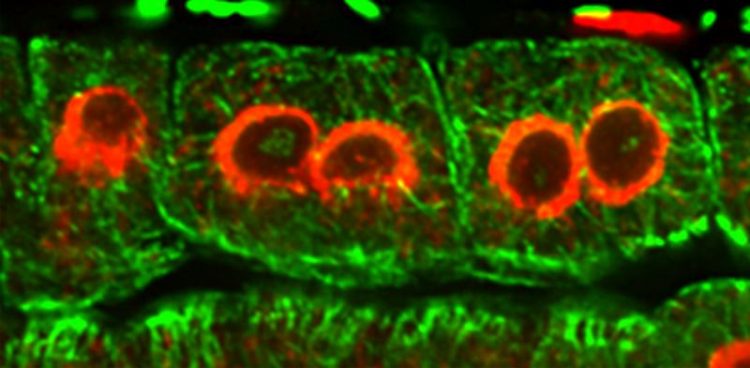Cell division in plants: How cell walls are assembled

Due to the defect, cells with more than one nucleus (red) were formed in the plant. Ingo Heilmann (The EMBO Journal)
For their study, the plant researchers examined the roots of the thale cress plant, Arabidopsis thaliana. They cultivated normal plants and plants in which they artificially switched off certain enzymes that affect the composition of the membranes.
“We wanted to find out which membrane building blocks are important for cell division and why,” explains Professor Ingo Heilmann from MLU.
For plants to develop, their cells have to divide. First, the genetic material located in the cell nucleus divides. Two whole new cell nuclei are formed from the duplicated genetic material.
The other components of the cell, for example the chloroplasts and mitochondria, are distributed between the two future daughter cells. All this takes place in the parent cell.
Only then the daughter cells will be separated by a new cell wall. The whole process can be compared to a construction site. First, a temporary scaffold made of protein fibres, the so-called phragmoplast, forms in the middle of the cell.
Like railway tracks, these fibres guide the building materials needed for the cell wall. Small bubbles gradually transport new cell wall material along the rails. This is assembled together by a complex fusion machinery to form a larger structure: the cell plate. The cell plate continues to grow at its edges from the centre of the cell outwards until a cell wall disc completely separates the daughter cells from one another.
“The fusion machinery has to correctly coordinate the protein fibres for everything to function properly, otherwise the freight cars will transport the cell wall material to the wrong spot or at the wrong time and cell plate formation will cease,” explains Heilmann.
Using biochemical and cell biology experiments, his research group was able to show that PI4P, a membrane building block, plays two roles during cell division: PI4P not only controls the activity of the fusion machinery, it also ensures the new material is transported in the right direction.
For the first time, the researchers were able to show that PI4P helps to ensure that the protein scaffold of the phragmoplast is assembled and disassembled in the right places. In normal plants, this results in regular cells that fit together perfectly and give the plant its needed stability.
In mutated plants, however, the scientists observed severe defects in cell division: They found enlarged cells containing several cell nuclei as a result of the unsuccessful separation of the daughter cells. Some cells were unable to divide completely, the cell tissue was chaotic, and there were enormous differences in the sizes of the individual cells. “This is not happy tissue. It makes the entire plant more unstable, reduces its size and impacts how it adapts to environmental stimuli,” explains Heilmann.
The results of the research group from Halle help to better understand the dynamics of the plant’s cytoskeleton of microtubules. The cytoskeleton not only determines the direction of cellular transport processes during cell division, but also directs general plant growth.
Therefore, the new findings could have far-reaching consequences, for example on the deposition of cellulose in plant cell walls and thus on biomass and cellulose production. However, it must first be determined whether the findings can also be applied to other plants and how the activity of the enzymes investigated here can be specifically regulated.
The study was funded by the Deutsche Forschungsgemeinschaft (DFG, German Research Foundation) and a grant from the Chinese Scholarship Council, and carried out in cooperation with the Leibniz Institute for Plant Genetics and Crop Plant Research (IPK Gatersleben).
Note to editors:
This press release is accompanied by additional image and video material. In the attached ZIP file you will find two videos of cell division in the thale cress. One video shows the normal process of cell division, another shows the disturbed process. Additionally included are recordings of normal and disordered cells of the thale cress. You can download the material here: https://cloud.uni-halle.de/s/32WD6FMbYR4CHNi
Lin F. et al. A dual role for cell plate-associated PI4Kβ in endocytosis and phragmoplast dynamics during plant somatic cytokinesis. The EMBO Journal (2019). doi: 10.15252/embj.2018100303
Media Contact
More Information:
http://www.uni-halle.deAll latest news from the category: Life Sciences and Chemistry
Articles and reports from the Life Sciences and chemistry area deal with applied and basic research into modern biology, chemistry and human medicine.
Valuable information can be found on a range of life sciences fields including bacteriology, biochemistry, bionics, bioinformatics, biophysics, biotechnology, genetics, geobotany, human biology, marine biology, microbiology, molecular biology, cellular biology, zoology, bioinorganic chemistry, microchemistry and environmental chemistry.
Newest articles

Solving the riddle of the sphingolipids in coronary artery disease
Weill Cornell Medicine investigators have uncovered a way to unleash in blood vessels the protective effects of a type of fat-related molecule known as a sphingolipid, suggesting a promising new…

Rocks with the oldest evidence yet of Earth’s magnetic field
The 3.7 billion-year-old rocks may extend the magnetic field’s age by 200 million years. Geologists at MIT and Oxford University have uncovered ancient rocks in Greenland that bear the oldest…

Decisive breakthrough for battery production
Storing and utilising energy with innovative sulphur-based cathodes. HU research team develops foundations for sustainable battery technology Electric vehicles and portable electronic devices such as laptops and mobile phones are…





















